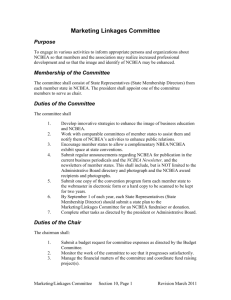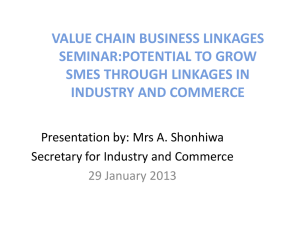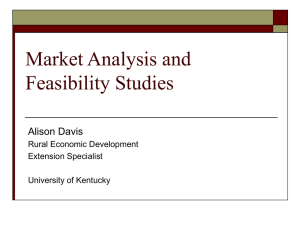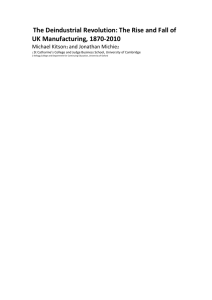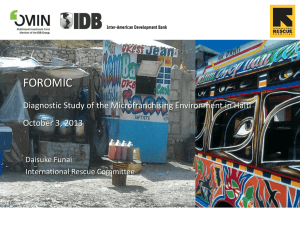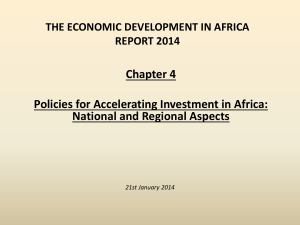Input-Output and SAM Multiplier Analysis
advertisement
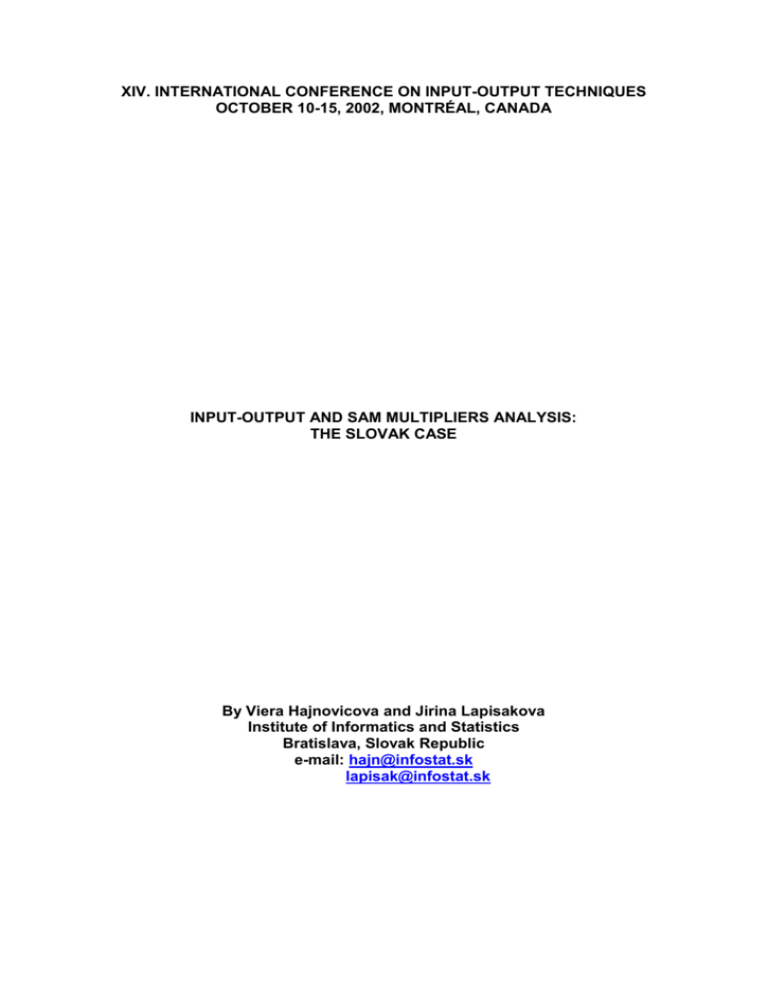
XIV. INTERNATIONAL CONFERENCE ON INPUT-OUTPUT TECHNIQUES OCTOBER 10-15, 2002, MONTRÉAL, CANADA INPUT-OUTPUT AND SAM MULTIPLIERS ANALYSIS: THE SLOVAK CASE By Viera Hajnovicova and Jirina Lapisakova Institute of Informatics and Statistics Bratislava, Slovak Republic e-mail: hajn@infostat.sk lapisak@infostat.sk Introduction Transition of economy to market economy determined the extensive structural changes in the Slovak economy. The aim of this paper is to analyse the structure of our economy from the aspect of inter-sectoral relations. Except the other factors, overall economic growth depends also on the sectoral growth rates, which are influenced by linkages between sectors. The sectors are linked not only with domestic activities but also with the rest of the world as well as with other actors of economy. To study these linkages the input-output tables are widely used. The multiplier analysis, based on Leontief inverse matrix, identifies the important direct and indirect relations between sectors. The extension of multiplier analysis on social accounting matrix (SAM) carries the new aspects in an analysis. The SAM provides framework for transparent economywide presentation of linkages between activities (or commodities), factors, households, domestic institutions and foreign institutions in a tabular format that is suitable for multiplier analysis. In this paper we use the SAM constructed for the Slovak Republic for 1998. The multipliers were calculated according to several scenarios in which we changed the selection of one or more exogenous accounts from among the general government, capital and rest of the world accounts. To identify the most important backward and forward sectoral linkages the normative average multipliers, calculated both from Leontief and SAM matrices, were used. 1. Social accounting matrix for the Slovak Republic The analysis is based on the consistent and comprehensive data set concerning all mutual transactions among productive and institutional sectors of the economy, which is represented by the social accounting matrix for the Slovak Republic for 1998 (table 1). SAM for the Slovak Republic is based on adjusted National accounts data as well as on Supply and Use Tables (SUT) for 1998. The Supply and Use Tables are compiled and published by 60 groups of commodities and 60 groups of activities. For analytical purposes, the SUT were partly adjusted and modified. The adjustments referred to the imports for further processing and distribution of subsidies. The adjusted SUT in basic prices were transformed into symmetric product by product Input-Output Table. Taking into account the great heterogeneity of SUT, the industry technology assumption was applied although it is not optimal approach. The SAM consists of 38 accounts, of which productive sphere is represented by 28 accounts (commodities)1. The commodity accounts represent the supply and use of goods and services of domestic origin in basic prices. The commodity accounts were consolidated from 60 product Symmetric Input-Output table. The factors are presented by three accounts, in which the generation of income within the economy and the rest of the world, respectively, are recorded. There are gross operating surplus (row 30), compensation of employees (r. 31) and other net taxes on production accounts (r. 32). On the row 29 the net taxes on products (value added tax, excise tax) connected with intermediate consumption and final consumption are recorded separately. In SAM three domestic institutional sectors are distinguished (rows 33,34,35): enterprises (non-financial and financial), government (including non-profit institutions 1 In this paper we say about productive sectors. 1 serving households), households (including self-employed). The distribution and use of income within these institutional sectors is shown in one consolidated account. Capital account (r. 36) represents possible economic funds created by savings, by net capital transfers receivable from abroad and by lending/borrowing from abroad. The Rest of the World (ROW) accounts record transactions of the rest of the world with the national economy. In the SAM two separate accounts are distinguished: one for current and capital transfers with ROW (r. 37) and one for goods and services transactions with ROW (r. 38). In case of imports, we distinguished imports of goods and services for intermediate consumption and for final use. In the SAM arranged this way, the main emphasise is put on production sphere of the Slovak economy, what corresponds to the targets of our analysis. 2. Basic tools used in analysis Multiplier analysis The analysis is based on two model approaches. The first approach is presented by standard Input-output Leontief model for which input coefficients and Leontief multipliers (ML) were calculated: ML = (E-A)-1, where A is matrix of input (technical) coefficients. The second model approach is based on extending of linear Leontief model to a SAM framework, what is performed by partitioning the accounts into endogenous and exogenous accounts and assuming that the column coefficients of the endogenous accounts are all constant. For determining the set of endogenous accounts it is important to know whether changes in the level of expenditures directly follow any change in incomes. Exogenous accounts are those for which we assume that the expenditures are set independently on incomes. Standard practice is to pick up for the exogenous accounts one or more accounts among the government, capital and the rest of the world accounts, justifying the choice on the basis of the objectives of the study. Multipliers calculated from the SAM are the simple indicators comprising the important information about structure of the given economy. They are calculated from the matrix of expenditures shares (general technical coefficients) after excluding the exogenous accounts. The computed multipliers will be sensitive to the choice of exogenous accounts and express the sensitivity of the endogenous accounts on changes in demand for exogenous accounts. SAM multipliers (MS) are calculated as: MS = (E-M)-1 , where M is matrix of expenditures shares of endogenous accounts. Comparing of multipliers calculated from the I-O and SAM models carries in the economic analysis new aspects. The SAM multipliers are much larger than corresponding input-output multipliers. Because value added is a leakage, only intermediate demand serves as multiplier in the input-output analysis. In contrast, value 2 added and incomes generate demand linkages in the SAM approach. SAM multipliers capture the different multiplier effects of exogenous accounts on productive activities, factors and institutions. Based on the partition of the endogenous section of the SAM into three categories of accounts –activities/commodities, factors and institutions - matrix of multipliers can be decomposed into four components: initial injection, transfer effects, open-loop effects and closed-loop effects. Many versions of this decomposition have been used. In analysing the productive sphere of economy we have used decomposition of multipliers by Pyatt and Round [1] and experience with application of this method [2]. The matrix MS which is reduced to the Leontief multiplier matrix ML corresponds only to the production accounts. To perform the impact analysis, the M S matrix is truncated to conform to the dimension of the matrix ML. The differences between both multiplier matrices, MS and ML, measure the induced effects due to the added endogeneity, while the direct and indirect effects are measured by ML. Matrix MS can be decomposed into three components: (MS – ML), which measures induced effects (E + A), which measures direct effects (ML – E – A), which measures indirect effects, where: MS = (MS – ML) + (E + A) + (ML – E – A). Important linkages The importance of relations between productive sectors and their impact on economic growth were examined through so-called backward and forward linkages. Theoretical analysis as well as empirical studies show that a sector cannot stand alone in order to function properly it needs good relations with other sectors. Inputoutput tables are a useful tool for studying these linkages. Chenery&Watanabe [3] used the elements from the input coefficients matrix to compute the direct effects of an increase in the production of a certain sector. The backward linkages are represented by shares of inputs of all productive sectors on one unit of output produced in the individual sector (technical coefficients). The forward linkages show the dependence of the given sector on the consumers of its production, i.e. they are represented by shares of output produced in the given sector in the total output of other sectors (distributive coefficients). In our work we used the Rasmussen method [4], which originally was applied on the Leontief multiplier matrix. The indicators computed by Rasmussen method contain the higher-order effects. Aggregation of all elements in a column of the Leontief multiplier matrix gives the cumulative backward linkages of an activity. It expresses the increase of weight of the given activity in the total output produced in the entire economic system, if the final demand of production of given sector increases by exactly one unit. The aggregation of all elements in a row of the Leontief multiplier matrix denotes the forward linkages. We applied Rasmussen method also on the SAM multiplier matrix to determine backward and forward linkages. The backward linkages are given by row multiplier vector which represents the sum of multipliers of endogenous columns, i.e. e t (E-M)-1. 3 If we divide elements of the row multiplier vector by the number of endogenous accounts (n), we obtain the vector of average responses to exogenous injections. The measure of forward linkages is given by a column vector, which represents the sum of multipliers of endogenous rows, i.e. (E-M)-1 e. The average multipliers, which we obtain by dividing by number of endogenous accounts (n), determine the average forward linkages responses to a uniform total injection by one unit. Indicator S = (et (E-M)-1 e)/n2 is the average multiplier of the whole multiplier matrix, i.e. the average multiplier taking into account both backward and forward linkages. We have selected the most significant linkages, for which the normalized values of multipliers exceeded value of 1. The normalized multipliers were calculated as: u = (et (E – M)-1)/S w = ((E – M)-1 e)/S. They determine the accounts with the most important backward and forward linkages. 3. Analytical results Analytical results are divided into 2 parts. In the first part we have analysed intersectoral relations, as this type of analysis belongs to the crucial issues in conditions of limited national as well as foreign resources. As possibilities of the SR to import products from the rest of the world are limited, permanent decrease of direct and indirect requirements of output produced in national economy on inputs plays very important role in giving rise the effectiveness of reproduction process. For analytical purposes we used the symmetric IOT in commodity breakdown, which forms the important part of the SAM and provides unique data source for deeper analysis of requirements on direct and indirect consumption of goods and services. In the second part we have identified sectors with important backward and forward linkages. Analysis of importance of these linkages is based on the IO and SAM multipliers. 3.1 Analysis of direct and indirect consumption of goods and services When analysing the inter-sectoral linkages we have examined the key groups of commodities from several aspects: Based on input-output coefficients we have identified the direct requirements of domestic production on consumption of domestic and imported goods Based on Leontief multipliers we have calculated the direct and indirect effects of one unit of domestic production delivered to the final use on inputs from national economy and the rest of the world (table 2). Analytical results are presented by sectors: Agriculture, hunting, forestry and Fishing (A,B) Impact of transformation process and structural changes, which occurred in the Slovak economy, on this sector were very strong. Mainly price liberalisation, opening of the price scissors, significant reduction in subsidies, low competitiveness of the 4 Slovak producers compared to producers from European Union and limited financial resources caused that the Slovak agriculture had adapted on new market economy conditions very slowly. The share of agriculture, hunting, forestry and fishing in the total amount of output produced in the whole SR permanently decreased, to the level of 4,7% in 1998. Direct requirements of production produced in agriculture, hunting, forestry and fishing on consumption of domestic production were 0,498 SKK per unit of output (they were by 6 % higher than the average for the whole economy). The highest share in intermediate consumption represented deliveries of agricultural products (intra-sectoral turnover reached 0,224 SKK per unit of output), ready-made fodder and other supplements for feeding of animals, consumption of electricity, gas and hot water and market services (wholesale, transport and storage). On the other hand agriculture is relatively less dependent on imports. Direct requirements of one unit of agricultural production on imports represented 0,123 SKK, of which deliveries from manufacture reached the value of 0,071 SKK (of which artificial fertilisers, chemical spraying and other chemicals represented 0,051 SKK) and consumption of imported agricultural products 0,037 SKK. As regards to the domestic production, agriculture, hunting, forestry and fishing belong to sectors with high Leontief multipliers (1,964). One unit increase in demand for their production, delivered into the final use, has the greatest multiplicative effects on agricultural products (where it induces an extra increase by 0,316 units) and on production produced by the other sectors (increase by 0,648 units). Agriculture has the closest linkages with manufacture of food products, beverages and tobacco (deliveries of fodder and fodder supplements for the animals), market services (wholesale, transport and storage, real estate, renting and business services and financial intermediation) and electricity, gas and hot water supply. In case of domestic production the share of direct consumption reached 48,3% and the share of indirect consumption, transmitted to the given sector through its inputs, reached almost 52%. Needs to satisfy an extra demand in the sphere of final use induced the rise of direct and indirect consumption of imported goods and services by 0,266 units, of which requirements on imported agricultural products increased by 0,053 units and imports of remaining commodities by 0,213 units (of which the greatest multiplicative effects this sector had on consumption of artificial fertilisers, chemical spraying and other chemicals, coal, crude petroleum and natural gas and agricultural products). Almost 54% of imported inputs were consumed indirectly. Industry (C, D, E) Industry, which includes Mining and quarrying, Manufacturing and Electricity, gas and water supply, belongs to the most important sectors in the Slovak economy. In the process of transformation and adaptation to the market conditions the weight of industrial production permanently decreased, so in 1998 it covered 41,8% of the total output produced in the whole SR. Differentiated development of particular sectors of industry reflected in gradual structural changes of output and value added. While Mining and quarrying and Manufacturing showed in 1998 values of direct requirements on consumption of domestic production (input coefficients) below the 5 average ones (calculated for the whole economy), Electricity, gas and water supply belong to sectors, production of which needs the highest intermediate consumption from all sectors performed in the whole economy (0,527 SKK per unit of production). Problem is that many goods and services used for intermediate consumption in all three mentioned groups of sectors (C,D,E) must be imported from the rest of the world. From analysis of IO multipliers follows that 55% of domestic production produced in mining and quarrying as well as in manufacturing was used directly, while in case of imported goods and services the share of direct consumption in IO multipliers reached 65%. The rest was used indirectly. Manufacture of food, beverages and tobacco products, leather and wood products, basic metal and fabricated metal products as well as manufacture of pulp, paper and paper products reported the highest input coefficients from all sectors of Manufacturing. The highest input coefficients for imported goods and services represented manufacture of motor vehicles (as the firm Volkswagen is oriented predominantly on assembling of cars), rubber and plastic products, coke and refined petroleum products and electrical and optical equipments. Analysis of IO multipliers was oriented mainly on key sectors of Manufacturing: DA – Manufacture of food products, beverages and tobacco products This sector has the highest IO multiplier for domestic production (2,305). It follows that manufacture of food, beverages and tobacco has very strong multiplicative effects on many other sectors of the Slovak economy (with IO multiplier 0,937) as well as strong intra-sectoral linkages (0,369). This sector is very closely linked mainly with agriculture (0,273), manufacture of pulp, paper and paper products (0,051), electricity, gas and water supply (0,091) as well as with market services, such as trade (0,117), transport and storage (0,116) and real estate, renting and business activities (0,096). One unit increase in productive activities in this sector requires 0,291 units of the extra imports for intermediate consumption, mainly imports of agricultural and chemical products and paper and plastic products for wrapping. DG – Manufacture of chemicals, chemical products and man-made fibres Producing of extra output produced in this sector and delivered to final use, requires the increase in production of all sectors of the Slovak economy by 1,667 units, of which production of chemical products increases by 0,152 units and production of all the other sectors by 0,515 units (of which the rise of consumption of electricity, gas and hot water, transport and storage and other market services was the most expressive). Besides above mentioned increases in consumption of domestic production, the further increase of production activities in this sector requires also higher deliveries of imported goods and services (by 0,480 units), mainly deliveries of coal, crude petroleum and natural gas (by 0,123 units) and chemical products and man-made fibres (by 0,239 units). This means that increase of production activities in this sector puts heavier demands on imports of chemicals than on their domestic production. 6 DJ – Manufacture of basic metals and fabricated metal products IO multipliers in manufacture of basic metals and metal products calculated for domestic production represented in 1998 1,900 units. This sector has expressive multiplicative effects on intra-sectoral deliveries (0,253), while the total impact of all the other sectors equals to 0,647 (of which the greatest impact occurred in manufacturing of electricity, gas and hot water, coke and refined petroleum products, machinery and equipment and market services – trade, transport and real estate, renting and business services). Production of extra output for final use requires 0,45 units of extra imports, of which imports of basic metals increase by 0,169 unit, coke, crude petroleum and natural gas by 0,076 unit and metal ores by 0,050 unit. DK – Manufacture of machinery and equipment Machinery has very long history in the SR. This sector is linked with many other sectors, mainly with manufacture of basic metals and metal products, electrical and optical equipment, construction and market services (trade, transport and storage and real estate, renting and business services). IO multipliers calculated for domestic production are relatively high (1,811). But increase in deliveries of machinery and equipment to the final use by one unit requires also increase in imports for intermediate consumption by 0,431 units (first of all imports of basic metals and metal products, machinery and equipment and electrical and optical equipment). DL – Manufacture of electrical and optical equipments The extra imports of goods and services from abroad for further processing form a necessary presumption for increase of production activities in this sector. IO multipliers for domestic production reached in 1998 the value of 1,537 and multipliers for imports the value of 0,530 units. This sector has the highest multiplicative effects on manufacture of basic metals and metal products (0,081), on intra-sectoral deliveries (0,101) and on electricity, gas and water supply (0,044). Manufacture of electrical and optical equipment is relatively dependent on direct and indirect consumption of imported goods and services, of which imports of electrical and optical equipment, basic metals and rubber and plastic products (insulators) are the most important. DM – Manufacture of motor vehicles In 1996-1998 manufacture of motor vehicles belongs to sectors with the greatest dynamics of development. As in this period Volkswagen established in the SR its affiliate office oriented predominantly on assembling cars, this sector started to be dependent on imports for intermediate consumption from the rest of the world (with multiplier 0,710). There are mainly imports of machines and equipment, components for vehicles, electrical and optical equipment and metal products. On the contrary, producing of one unit of extra production delivered to final use has lesser impact on domestic production. In 1998 it induced increase in production of motor vehicles by 0,075 units and in all the other sectors by 0,274 units, of which the greatest influence it had predominantly on manufacture of basic metals, metal products, machinery electricity, gas and water supply, transport and storage or on the other market services. 7 Construction (F) After the period of recession in the beginning of transformation process, in 1996 a recovery of construction activities occurred partly due to the better financial situation in enterprises and the increased demand from abroad, but mainly thanks to building of motorways financed from the State budget. This revival caused the increase in the share of construction in the structure of output produced in the whole SR up to 8,72% (in 1998). Development of construction activities induced growth of requirements on intermediate consumption of goods and services both from domestic production as well as from imports. Direct requirements on consumption of domestic production (characterised by input coefficients) represented in 1998 0,537 SKK per unit of output, of which the greatest demand was put on consumption of other non-metallic mineral products, basic metals and metal products, construction works, transport, trade and other market services. Demand for imports is relatively small, deeply below the average value. Construction is closely linked with many production activities. High IO multiplier for 1998 depicted that increase in construction works by one unit delivered to final use induces the growth of the total output by 2,024 units. Of which multiplier 1,238 for construction works means that one unit will be delivered to final use and 0,238 units determine induced output produced in this sector as well as multiplier 0,786 determines the level of production which should be produced by the other sectors. In case of domestic production, construction has the greatest multiplicative effects on manufacture of other mineral products, basic metals and metal products, on machinery, electricity, gas and water supply and market services (transport, trade and real estate, renting and business services). Direct and indirect requirements on imported goods refer mainly to other commodities, not to imports of construction works. Services Services developed very fast in the whole period of transformation. Their share in the total production for the whole economy represented in 1998 almost 45%. For services is typical higher share of generated value added and lower share of intermediate consumption. High dynamics of growth had mainly market services, of which the greatest boom showed real estate, renting and business services and trade. Market services gradually absorbed employees who were dismissed from industry and agriculture. At present, almost one third of total employees is working in market services. Analysis based on input coefficients depicted lower requirements of market services on consumption of imported goods and services, below the average values and higher requirements on consumption of domestic production (higher in trade, hotel and restaurant services and transport and lower in financial intermediation and real estate, renting and business services). Analysis of IO multipliers showed that the greatest effects on the other sectors of the Slovak economy had trade, hotel and restaurant services, transport and communication or real estate, renting and business services, i.e. activities development of which is linked almost with all sectors producing domestic production. 8 Development of non-market services was influenced mainly by two facts. The volume of non-market services in the general government sector rose after 1993 due to splitting up the Czechoslovak Republic and establishing the independent Slovak Republic and in sectors, which before transformation were fully oriented on providing of non-market services (education and health), many market activities started to be performed. For non-market services is typical low share of direct consumption of domestic and imported production. The greatest multiplicative effects on the Slovak economy had public administration and defence (including compulsory social security) and other non-market services. The greatest impact of the State was depicted mainly in agriculture, electricity, gas and water supply, construction, trade, transport and real estate activities. 3.2 Analysis of inter-sectoral linkages The first part of our analysis was oriented on studying the effects of a specific sector on the other sectors. In this part we have analysed the importance of sectors on the basis of their linkages within the economic system as a whole. The important backward and forward linkages of specific sectors were determined by applying Rasmussen method at first on the IO multiplier matrix and then on the SAM multiplier matrix. Rasmussen method applied on the IO multiplier matrix Indicator of backward linkages (called also power of dispersion) calculated from IO multipliers represents the necessary production of all sectors of the economy, which ensures inputs of these sectors into particular sector to provide one unit of production supplied into final use. The particular sector is evaluated from the demand side. On the contrary, forward linkages indicator (also index of the sensitivity of dispersion) of the particular sector represents necessary volume of production of all sectors to absorb influence of growth of primary inputs of particular sector by one unit. It means that this sector is evaluated from the supply side. In the Slovak economy 15 sectors with important backward linkages were determined in 1998. The most important were: manufacture of food products, beverages and tobacco, leather and leather products, manufacture of wood and wood products, construction, electricity, gas and water supply and agriculture. Generally, there are sectors with high direct and indirect requirements on consumption of domestic production. As far as the linkages to the consumer sectors concern, the calculated indicators have determined 9 sectors with the important forward linkages. There were mainly market services, construction, electricity, gas and water supply, agriculture, manufacture of basic metals and metal products and manufacture of food products. The analysis has shown that among sectors with the most important both linkages within the economic system in the Slovak economy belonged from the market services transport and trade and from the other sectors: agriculture, manufacture of food products, basic metals and fabricated metal products, electricity, gas and water supply and construction. 9 Rasmussen method applied on the SAM multiplier matrix The extension of multiplier calculation on the whole SAM enables to evaluate more objective linkages of individual sectors. Except of direct and indirect effects, SAM multipliers take into account also induced effects which display via impact of exogenous injections on incomes of institutions; incomes evoke another changes of consumption and backwards, they induce also changes in productive activities. We calculated the induced effects as the difference between the SAM multiplier and the IO multiplier in absolute and relative values. The SAM multipliers were computed from the SAM after excluding the exogenous accounts. We processed several variants: The basic variant considers all three exogenous accounts: general government, rest of the world and gross capital formation. Our target was to investigate what impact would have the unit change in particular exogenous accounts on linkages among sectors. Absolute values of multipliers and values of induced effects are presented in tables 3,4. The share of induced effects on the average SAM multiplier for total of all sectors is about 24 %. The highest values of induced effects, which influence backward linkages, were primarily in market as well as in non-market services. In manufacturing (except manufacture of food, leather and wood products) the induced effects were under average. Exogenous injection had important influence also on the agriculture and construction. Important induced effects influencing forward linkages appeared in less size, mostly in these sectors: agriculture, manufacture of food products, electricity, gas and water supply, transport and real estate, renting and business activities. Comparison of important SAM multipliers with important IO multipliers depicted that selected sectors are nearly identical. Taking into account the influence of the induced effects on backward linkages, also services of real estate were included among the important activities. On the contrary, no important multipliers were confirmed in the manufacture of basic metals and fabricated metal products, machinery and equipment. Similar results were reached also in the forward linkages multipliers. The importance of SAM multipliers confirmed also sectors with important IO multipliers (except of services of financial intermediation). In the following three variants we have examined the impacts of exogenous injections separately for every exogenous account. In the first variant the general government was selected as the exogenous account. The results said that from 28 sectors 17 sectors have important SAM backward multipliers (tables 5,6). There are mostly productive activities in the manufacturing, also agriculture, electricity, gas and water supply and construction. In majority of these sectors the important induced effects were confirmed. On the basis of multipliers expressing forward linkages, among the important activities belonged from the manufacturing only manufacture of transport equipment, food products and manufacture of basic metals. Impact of induced effects showed 76 % of value of average SAM multiplier. The important multipliers in both directions were confirmed in 6 sectors: agriculture, manufacture of food products, basic metals 10 and fabricated metal products, transport equipment, electricity, gas and water supply and construction. In the second variant the rest of the world was selected as the exogenous account. We have explored the reactions of individual sectors on changes in foreign trade balance. In this variant, the share of average value of induced effects in SAM multiplier has reached 60 % (tables 7,8). Surprising, important induced effects of the rest of the world were depicted mainly in market and non–market services and from the manufacturing sectors only in the manufacture of food products, wood and wood products, manufacture of other non-metallic mineral products as well as in agriculture. The important SAM multiplier was confirmed in majority of sectors with important IO multiplier, except of manufacture of basic metals and fabricated metal products, machinery and equipment, electricity, gas and water supply in which the value of SAM multiplier was under average. On the contrary, in the market and non-market services, which had no important IO multipliers, the SAM multipliers reached important values due to the influence of induced effects. In the forward linkages the important induced effects were depicted in the same productive activities, which had also important IO multiplier. In the third variant in which the account of gross capital formation was selected, the highest values of SAM multipliers occurred. The share of induced effects on the average SAM multiplier has reached up 85 % (tables 9,10). The important reaction of productive activities on investments have been seen in nearly all sectors of manufacture (except of manufacture of textiles and textile products), mainly in manufacture of electrical and optical equipment, transport equipment and chemical products, in which no important IO multiplier were found. The impact of induced effects sustains the importance of backward linkages also in the agriculture and in electricity, gas and water supply. Due to the influence of induced effects, among sectors with the important forward linkages were included also sectors which had not important IO multipliers, as manufacture of pulp and paper products, manufacture of machinery, electrical and optical equipment and transport equipment. 4. Conclusion In 1998 the analysis of inter-sectoral relations based on Leontief and SAM multipliers depicted some important linkages in the Slovak economy: Among sectors, production of which is predominantly oriented on domestic raw materials, materials and semi-products, belonged the following manufacturing sectors: manufacture of food and beverages, leather, pulp and paper products, wood and other non metallic mineral products. The development of these sectors has therefore positive backward impacts on development of the other sectors of the Slovak economy producing domestic goods and services. The analysis also depicted that agriculture with important backward and forward linkages, plays important role in development of many other sectors of the Slovak industry. Manufacture of chemical, rubber and plastic products is highly dependent on consumption of imported goods, so its linkages on the other domestic producers are relatively small. 11 Manufacture of machines and equipment as well as manufacture of basic metals and metal products have long history in the Slovak Republic, though their production is very import demanding. Despite, both production activities occurred also important backward linkages on domestic producers. On the other hand, the analysis confirmed that the development of manufacture of transport vehicles has no important backward linkages to domestic producers. It is based almost exclusively on materials and semi-products imported for further processing. The similar situation is also in manufacture of electrical and optical equipment. From the presented variants of simulations we have selected the following tendencies: the most sensitive reactions on changes in exports were found in agriculture and manufacture of food products, wood and wood products and in market and non market services. There are activities with relatively high shares of exports and relatively small shares of direct and indirect requirements on imported goods and services, the developments of which supports mainly domestic producers. On the other hand, the other manufacturing sectors showed relatively low sensitivity on changes in exports. This follows from the fact, that production of key manufacturing activities (such as manufacture of transport equipment, electrical and optical equipments, manufacture of basic metal and metal products and chemical products) is oriented mostly on consumption of imported raw materials, materials and semi products. This decreases the currency effectiveness of their exports. all sectors of manufacturing (excluding manufacture of food, wood and leather products), agriculture, construction and electricity, gas and water supply show the important reactions on changes in government expenditures. Except of construction, there are activities, which are partly subsidised from the State budget. On the other hand, till 1998 in development of construction works played very important role state orders (building of motorways and infrastructure). the investment activities in wide degree induce the important effects in manufacturing sectors, mostly in chemical and machinery production. The important induced effects were also observed in agriculture and electricity, gas and water supply. It is very difficult to conclude some tendencies from these results because the exogenous account – gross capital formation – includes together with investments also changes in inventories. Our analysis confirmed that induced effects of exogenous injections have important impact on linkages among sectors and they should be considered in economic analyses. In our paper we presented the multipliers analysis only for one part of SAM, for commodity accounts. In the future, the extension of multiplier analysis on the other parts of SAM can bring more complete view on the structure of the Slovak economy. 12 References: [1] Pyatt, G. & Round, J.: Accounting and Fixed Prices Multipliers in a Social Accounting Framework, Economic Journal, N89, 1979. [2] Cardenete, M. A., Sancho, F.: Impact Assessment Using a Social Accounting Matrix. In: 13. International Conference on Input-Output Techniques. Macerata, 2000. [3] Chenery, H. B., Watanabe, T.: International comparisons of the structure of production, Econometrica, 26, 1958. [4] Rasmussen, P. N.: Studies in Intersectoral Relations. Amsterdam, NorthHolland, 1956. [5] Pfajfar, L., Dolinar, A. L.: Intersectoral linkages in the Slovenian economy in the years 1990, 1992, 1993 and 1995. In: 13. International Conference on Input-Output Techiques. Macerata 2000. [6] Lapišáková, J., Hajnovičová, V.: The impact of internal and external disparities on the structure of the Slovak economy. Inter-industrial Relations in Economic Modelling Central European Conference, Balatonfured. Hungary, 2000. [7] Reinert, K. A., Roland-Holst, D. W.: A detailed Social Accounting Matrix for the USA, 1988. Economic Systems Research, Vol. 4. No 2, 1992. [8] Sadoulet and De Janvry: Quantitative Development Policy Analysis. 1995. [9] Hajnovičová, V.: Use of SAM tables for economic analysis in the Slovak Republic. In: Regional International Input - Output Conference. Arusha, Tanzania 12 - 17th September 1999. [10] Lapisakova, J.: The impact of external and internal disparities on structural changes in the Slovak economy. Working paper. Institute of Forecasting SAS, 1999 (in Slovak). [11] The development and changes in inter industrial relations. (In Slovak) Aktá No. 16. INFOSTAT, 1999. [12] Lapišáková, J., Mokrášová, V.: Methodological problems of compilation of Input-Output tables in the Slovak Republic. In: Twelfth Conference on Input – Output Techniques, New York, 18 - 22nd May 1998. [13] Tarp, F., Roland-Holst, D., Rand, J.: Trade and Income Growth in Vietnam: Estimates from a New Social Accounting Matrix. Economic System Research. Volume 14, No: 2, 2002. [14] Hoen, A. R.: Identifying Linkages with a Cluster-based Methodology. Economic System Research. Volume 14, No: 2, 2002. 13 [15] Hajnovicova, V.,Lapisakova, J., Mokrasova, V.: Development of Slovak economy from point of wiev of inter-sectoral relationships. (in Slovak). Aktá No. 15. INFOSTAT, 2001. [16] Lapisakova, J., Hajnovicova, V.: Transformation of Supply and Use Tables for the Slovak Republic into Symmetric Input-Output Table. INFOSTAT. 2002. [17] Supply and Use Tables for the Slovak Republic by Commodities and Industries for the year 1998. Statistical Office of the Slovak Republic. Bratislava, 2000. [18] National Accounts of the Slovak Republic. Statistical Office of the Slovak Republic. 14



